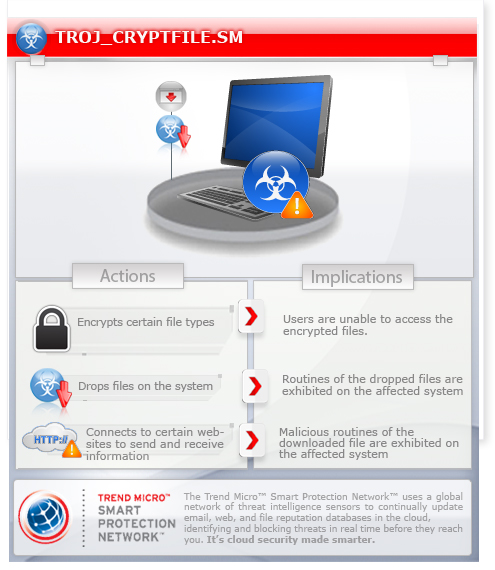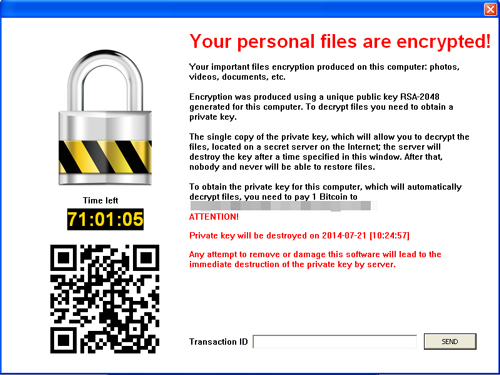TROJ_CRYPTFILE.SM
Trojan:Win32/Dynamer!ac (Microsoft); Trojan.Cryptolocker.E (Symantec); Trojan-Ransom.Win32.Blocker.ezuf (Kaspersky); Troj/Agent-AHVK (Sophos); Trojan.Win32.Generic!BT (Sunbelt); Trojan horse Pakes_c.CGQN (AVG)
Windows 2000, Windows Server 2003, Windows XP (32-bit, 64-bit), Windows Vista (32-bit, 64-bit), Windows 7 (32-bit, 64-bit)


Threat Type: Trojan
Destructiveness: No
Encrypted: Yes
In the wild: Yes
OVERVIEW
This variant of Cryptolocker encrypts files with specific file sizes. This routine impacts files with smaller file sizes such as documents and text files.
To get a one-glance comprehensive view of the behavior of this Trojan, refer to the Threat Diagram shown below.

This Trojan arrives on a system as a file dropped by other malware or as a file downloaded unknowingly by users when visiting malicious sites.
It connects to certain websites to send and receive information. It deletes itself after execution.
TECHNICAL DETAILS
Arrival Details
This Trojan arrives on a system as a file dropped by other malware or as a file downloaded unknowingly by users when visiting malicious sites.
Installation
This Trojan drops the following copies of itself into the affected system and executes them:
- %Application Data%\{random characters 1}.exe
(Note: %Application Data% is the current user's Application Data folder, which is usually C:\Documents and Settings\{user name}\Application Data on Windows 2000, XP, and Server 2003, or C:\Users\{user name}\AppData\Roaming on Windows Vista and 7.)
Autostart Technique
This Trojan adds the following registry entries to enable its automatic execution at every system startup:
HKEY_CURRENT_USER\Software\Microsoft\
Windows\CurrentVersion\Run
{Default} = "%Application Data%\{random characters 1}.exe"
Dropping Routine
This Trojan drops the following files:
- %Application Data%\{random characters 2}
- %Application Data%\{random characters 3}
- %Application Data%\{random characters 4}
- %Application Data%\{random characters 5}
(Note: %Application Data% is the current user's Application Data folder, which is usually C:\Documents and Settings\{user name}\Application Data on Windows 2000, XP, and Server 2003, or C:\Users\{user name}\AppData\Roaming on Windows Vista and 7.)
Other Details
This Trojan connects to the following website to send and receive information:
- http://{BLOCKED}lsylrytseewooketh.biz
- http://{BLOCKED}lsylrytseewooketh.biz:8080/photostocks.php?id={random}
- {BLOCKED}1.76.219
It deletes itself after execution.
NOTES:
This trojan encrypts the files with the following extensions:
- 3fr
- 7z
- accdb
- ai
- arw
- bay
- bmp
- c
- cdr
- cer
- chm
- cpp
- cr2
- crt
- crw
- csv
- cxx
- dbf
- dcr
- der
- djvu
- dng
- doc
- docm
- docx
- dwg
- dxf
- dxg
- eps
- erf
- fb2
- gif
- gz
- h
- img
- indd
- jpe
- jpeg
- jpg
- kdc
- mdb
- mdf
- mef
- mht
- mrw
- nef
- nrw
- odb
- odc
- odm
- odp
- ods
- odt
- orf
- p12
- p7b
- p7c
- pdd
- pef
- pem
- pfx
- pht
- ppt
- pptm
- pptx
- psd
- pst
- ptx
- r3d
- raf
- rar
- raw
- rtf
- rw2
- rwl
- sr2
- srf
- srw
- sxw
- tif
- txt
- wb2
- wpd
- wps
- x3f
- xlam
- xlk
- xls
- xlsb
- xlsm
- xlsx
- xltm
- xltx
- zip
After successfully encrypting files on the infected system, It informs the user that the personal files are encrypted.

SOLUTION
Step 1
Note that not all files, folders, and registry keys and entries are installed on your computer during this malware's/spyware's/grayware's execution. This may be due to incomplete installation or other operating system conditions. If you do not find the same files/folders/registry information, please proceed to the next step.
Step 2
Before doing any scans, Windows XP, Windows Vista, and Windows 7 users must disable System Restore to allow full scanning of their computers.
Step 3
Scan your computer with your Trend Micro product and note files detected as TROJ_CRYPTFILE.SM
Step 4
Restart in Safe Mode
Step 5
Delete this registry value
Important: Editing the Windows Registry incorrectly can lead to irreversible system malfunction. Please do this step only if you know how or you can ask assistance from your system administrator. Else, check this Microsoft article first before modifying your computer's registry.
- In HKEY_CURRENT_USER\Software\Microsoft\Windows\CurrentVersion\Run
- {Default} = "%Application Data%\{random characters 1}.exe"
- {Default} = "%Application Data%\{random characters 1}.exe"
Step 6
Restart in normal mode and scan your computer with your Trend Micro product for files detected as TROJ_CRYPTFILE.SM. If the detected files have already been cleaned, deleted, or quarantined by your Trend Micro product, no further step is required. You may opt to simply delete the quarantined files. Please check this Knowledge Base page for more information.
Step 7
The following created files/folders/registry keys/registry entries cannot be identified by the user since there are no reference values in the created key. The only way it can be identified is by comparing the present system information with a backup. Note that the said components do not have to be deleted since it won't be harmful to the system.
- %Application Data%\{random characters 2}
- %Application Data%\{random characters 3}
- %Application Data%\{random characters 4}
- %Application Data%\{random characters 5}
Did this description help? Tell us how we did.

